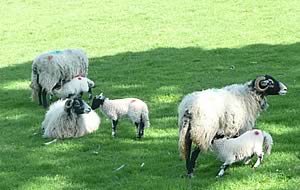19/05/08
SAC’s Disease Surveillance Centres has warned flock owners that Nematodirus battus worms could be a particular problem for lambs as they start to eat more grass.
 |
The risk of losses increases when a cold period in the spring is followed by a warm spell leading to a mass hatch of eggs on pasture. This year spring temperatures were slow to rise so it is anticipated that a simultaneous hatch of N battus larvae will occur from early May onwards, posing a threat to lambs from six weeks old all over Scotland. Early cases have already been recorded in Caithness, the Borders and Ayrshire.
Eggs of this parasite are particularly resistant to the elements, therefore the number of larvae tend to increase year on year to a threshold above which clinical disease occurs. Permanent and heavily stocked low ground pastures are particularly at risk, as are pastures with a history of the disease. If the Nematodirus hatch continues into June, hill lambs on improved pastures, which are relatively heavily stocked, may also be affected.
Nematodirus battus worms can cause a number of problems including sudden deaths, and watery scour and ill-thrift in survivors. Coccidiosis and kidney damage causing renal failure can also increase losses. The parasite can kill lambs before eggs appear in faeces, therefore if unexplained deaths occur in lambs, in order to diagnose or exclude the condition, freshly dead carcasses should be submitted to SAC Disease Surveillance Centres (DSCs) for post-mortem examination.
The main risk factors to consider are:
- A sudden, late cold snap which is followed by a period of warm weather (>10o C)
- Lambs grazing pasture that carried lambs (or occasionally calves) the previous spring
- Lambs that are old enough to be eating significant amounts of grass (6–12 weeks old)
- Hill lambs on improved pastures
Where the risk factors apply, treatment should start once the lambs reach 6 weeks of age. If the risk is high then do not wait for signs of scouring, but treat with a wormer effective against Nematodirus – check the data sheet before purchase. Group 1 (Benzimidazoles or BZs) and group 2 (Levamisole) and group 3 (Avermectin) wormers are normally effective against N battus. White drenches (BZs) should be effective against N battus even when on farms where this class of wormer is ineffective against other gutworms. If in doubt check faeces samples 7-16 days post treatment depending on product used.
As the rise in larval numbers on the pasture is extremely rapid, two doses at 7-10 day intervals are recommended for most situations. Where there is a particularly severe problem the best solution may be to move the ewes and lambs to low risk pasture (e.g. reseeded pasture) if available. Cattle do not develop clinical disease due to Nematodirus, but if grazed with sheep young calves can become infected and increase the build-up of larvae on the pasture. It is good practice to have faeces samples from all young stock checked regularly for evidence of worm eggs, not only to ensure animal welfare when challenge is high, but also to prevent needless dosing and decrease the risk of the development of anthelmintic resistance.
SAC offers a Wormscan service on bulk faeces samples to reduce cost – further details are available from your local SAC Disease Surveillance Centre.
 Rapid Test for Foot-and-Mouth Disease Now Available Rapid Test for Foot-and-Mouth Disease Now Available
 IAH Celebrates 50th Anniversary as World Reference Laboratory for FMD IAH Celebrates 50th Anniversary as World Reference Laboratory for FMD
 Sudden Death Warning for Beef and Dairy Farmers Sudden Death Warning for Beef and Dairy Farmers |



